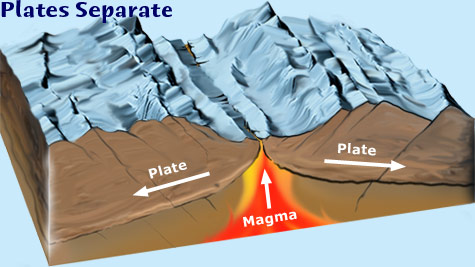| Home | Physics | Chemistry | Earth Science | Biology |
Seafloor Spreading
After World War II, Dr. Harry Hess studied Wegener’s ideas. Hess used sonar to map the seafloor. 3D models of the seafloor were created from sonar data. Within a few years, a curious terrain had emerged: vast, flat plains interrupted by ridges, or more precisely, vast mountain ranges. In the Atlantic Ocean, the “ridge” is about midway between the continents on either side, and thus it became known as a mid-ocean ridge. We now know that the ocean ridge system snakes around the entire globe in a continuous chain some 80,000 kilometers long.

After studying the mid-ocean ridge system, Hess proposed a hypothesis of seafloor spreading. He said that liquid rock, or magma, from Earth’s mantle is forced upward through the mid-ocean ridge system because magma has lower density than the surrounding rock. This causes the crust to crack (fault) and move apart. Twin mountain ranges are formed with a valley in between. A rift valley is a down-dropped valley between twin mountain ranges caused by faulting.
In the 1960s, scientists drilled into the ocean floor and took out samples, or cores, of the rock layers. Sediments near the continents are thick, but thin near the mid-ocean ridge system. Continental rocks are billions of years old, but seafloor rocks are less than 200 million years old. Rocks of the oceanic crust increase in age as their location extends from the mid-ocean ridge system.
We know that Earth’s magnetic field can reverse, causing the magnetic poles to reverse. The seafloor also has bands of reversed magnetic polarity. Geologists discovered bands of reversed polarity in the seafloor rocks similar to those on the continents. The bands are parallel and equally distant from the mid-ocean ridge system. As crystals form in magma pushing out at the mid-ocean ridge system, they take on the polarity of Earth when they form.
